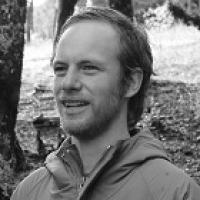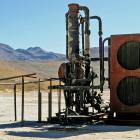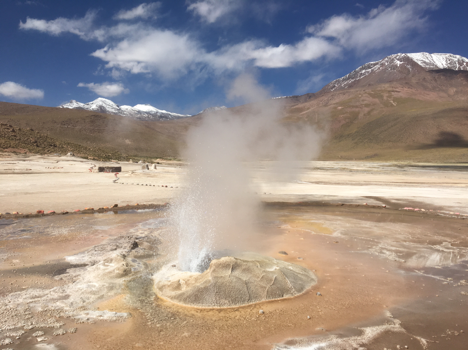
Fig. 1. Geyser eruption, El Tatio, 2019.
Fig. 1. Geyser eruption, El Tatio, 2019.
Photograph by Martín Fonck, 2019.
 This work is licensed under a Creative Commons Attribution 4.0 International License.
This work is licensed under a Creative Commons Attribution 4.0 International License.
In the Atacama Desert in northern Chile—high in the Andes—the largest geyser field in the southern hemisphere, the El Tatio geyser field, is located. In this valley, the geysers’ activity produces an atmosphere of steam and sulfur, expressing the irruption of underground phenomena on the surface. In 2009, the company Geotérmica del Norte S.A.—supported by the Italian company ENEL—explored El Tatio’s underground water reservoirs to evaluate the possibilities for, and ultimately produce, electric energy. Their initial plan was to drill deep geothermal wells, planning four wells between 2,000 and 2,500 meters deep (SEIA, 2007). Nevertheless, during the exploration, a column of steam exploded from inside the Earth, with its discharge lasting for 27 days and reaching as high as 60 meters (Vargas, 2018).
Loud subterranean noises followed the eruption. In response to this event, local organizations and Atacameño communities created the committee “La Defensa del Tatio,” protesting against geothermal exploration and ultimately causing the project to be shut down (Bolados García, 2014). This event received extensive media coverage (Otero, 2015), making visible conflicts related to underground water explorations in this area. El Tatio is located in Atacameño territories, where water is sacred. In the Andean context, mountains are considered a source of water, life, and the protection of ancestors (Carrasco, 2020).

Fig. 2. A column of steam produced by a geothermal well blowout.
Fig. 2. A column of steam produced by a geothermal well blowout.
Photograph by Gerard Prins, 2009.
Accessed via Wikimedia. Click here to view source.
 This work is licensed under a Creative Commons Attribution-ShareAlike 3.0 Unported License.
This work is licensed under a Creative Commons Attribution-ShareAlike 3.0 Unported License.
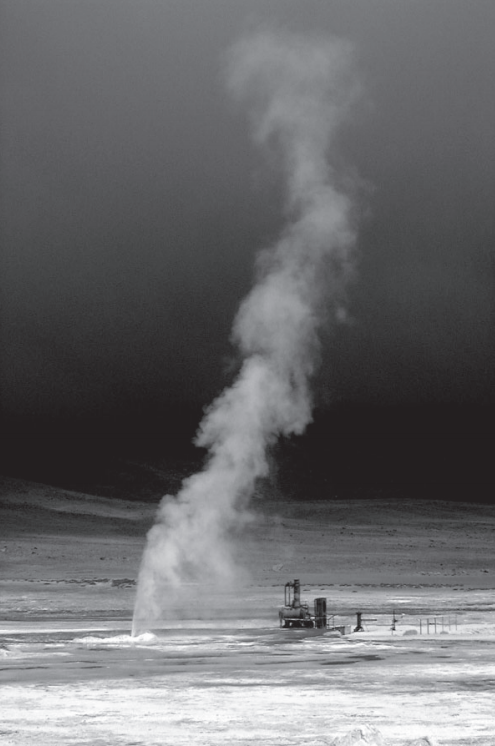
Fig. 3. Geyser steam and traces of geothermal exploration.
Fig. 3. Geyser steam and traces of geothermal exploration.
Photograph by J. Alan Glennon, n.d.
Courtesy of GeyserTimes
Used by permission
The copyright holder reserves, or holds for their own use, all the rights provided by copyright law, such as distribution, performance, and creation of derivative works.
However, less attention has been paid, from the humanities and social-science perspective, to the role of traces in this story. By traces, I understand the remains of past actions: “objects, leftovers, marks left by something that passed, architectural ruins, and defunct apparatus … Traces may be overlooked or discovered, intimately relished and forgotten, turned into tokens of sociality, or made banners of conflict. Traces are surprising, unexpected, rarely intentional, and sometimes scandalous” (Geissler et al., 2016: 15–16). Rather than only highlighting the absence of past actions, traces can also affect and produce unexpected futures, as this case shows. The official incident records (SEIA, 2009) indicate that the company reused a well that was constructed during previous explorations in 1973, and that the material conditions of this old well caused the explosion in 2009. During the reactivation of abandoned infrastructure, the steam temperature and pressure caused the well to collapse.
In this story, the role of traces, in the form of past human technological interventions and their environmental consequences, allows us to pay close attention to the politics and aesthetics of (in)visible and ignored subterranean dynamics, such as thermal flows. This piece focuses on the potential of traces and subterranean ecologies to interrupt and destabilize human technological interventions.
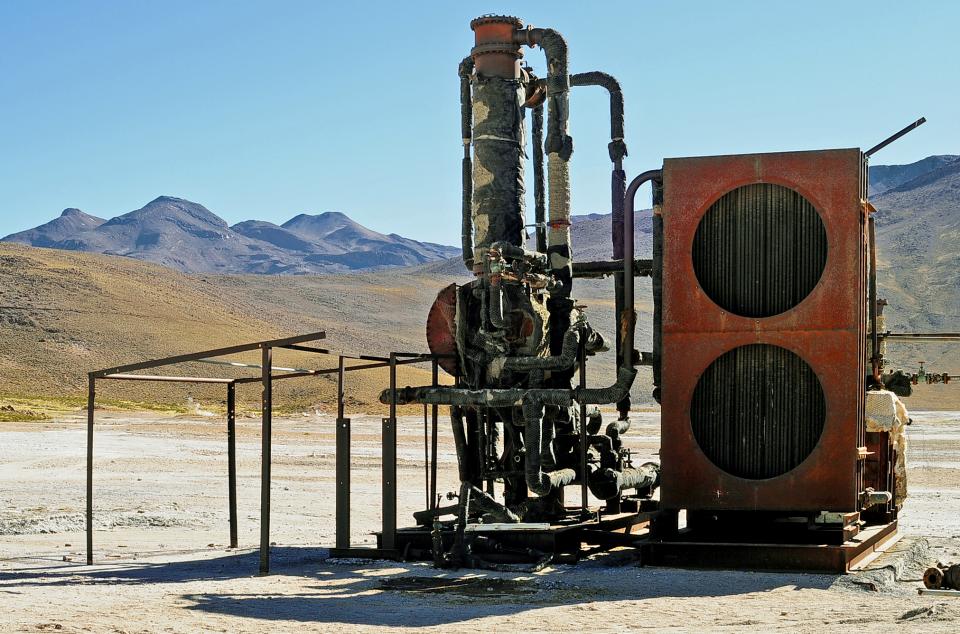
Fig. 4. Traces of geothermal energy projects in El Tatio.
Fig. 4. Traces of geothermal energy projects in El Tatio.
Photograph by LBM1948, 2008.
Accessed via Wikimedia. Click here to view source.
 This work is licensed under a Creative Commons Attribution-ShareAlike 4.0 International License.
This work is licensed under a Creative Commons Attribution-ShareAlike 4.0 International License.
Following traces in historical reports of geothermal explorations, human interventions below this place are not new. From the beginning of the twentieth century, engineers and geologists have been exploring and imagining geothermal energy futures in El Tatio. In 1923, Italian engineers described the first measurements they had made in this specific area of South America (Tocchi, 1923). Later, between 1968 and 1976, these explorations were continued by the Chilean Economic Development Agency (CORFO) and United Nations Development Programme (UNDP), who drilled exploratory wells to analyze the area’s geothermal potential (Lahsen and Trujillo, 1975). However, these projects and their promise were abandoned as well, leaving material traces on this place’s surface that are still visible today, as figures 3, 4, and 5 show.
Visiting this place nowadays, overwhelmed by this scenario’s visual impact, catching a glimpse of the field, it is also possible to recognize traces of abandoned machinery from geothermal energy explorations.

Fig. 5. A geyser cone and a geothermal well.
Fig. 5. A geyser cone and a geothermal well.
Photograph by Martín Fonck, 2019.
 This work is licensed under a Creative Commons Attribution 4.0 International License.
This work is licensed under a Creative Commons Attribution 4.0 International License.
Figure 5 shows a geothermal well. This trace was made by machines penetrating and drilling under the ground and a pipe descending. However, it does not just suggest a vertical descending movement. In the image, two gestures are present. The shape of the geyser shows an upward action, opposite to that of the well. The boiling water of the geyser rises from under the ground. These small sinter mounds created by the geysers’ eruptions are geological traces you can observe on the surface. Getting closer to the hole, you can hear the sound of the underground water boiling and coming to the surface.
In the depths of El Tatio’s underground, these abandoned traces are scattered. During the explorations mentioned in this piece, rocks and water flows were penetrated to install the wells. The abandoned exploration technologies are in constant contact with underground water. Infrastructures of exploration have had to coexist with thermal flows, experiencing a process of decay and material transformation.
In my current project about subterranean exploration and geothermal (in)visibilities in the Andes, I am studying these traces and the stories in which they are embedded. Interestingly, as the explosion at El Tatio shows, underground water’s physical characteristics constitute an unstable element. Water is fugitive, moving and changing its shape. The heat from the interior continuously transforms the physical state of the water and the materiality of underground wells. The activation of invisible subterranean water as a geothermal resource paradoxically became evidence of its uncontrolled presence.
How to cite
Fonck, Martín. “Subterranean (In)visibilities: Traces, Underground Water, and Thermal Flows in the El Tatio Geyser Field, Atacama, Chile.” Environment & Society Portal, Arcadia (2021), no. 24. Rachel Carson Center for Environment and Society. doi:10.5282/rcc/9316.
ISSN 2199-3408
Environment & Society Portal, Arcadia
 This work is licensed under a Creative Commons Attribution 4.0 International License.
This work is licensed under a Creative Commons Attribution 4.0 International License.
2021 Martín Fonck
This refers only to the text and does not include any image rights.
Please click on the images to view their individual rights status.
- Bolados García, Paola. “Los conflictos etnoambientales de ‘Pampa colorada’ y ‘El tatio’ en el Salar de Atacama, Norte de Chile: Procesos étnicos en un contexto minero y turístico transnacional.” Estudios atacameños 48 (2014): 228–48. doi:10.4067/S0718-10432014000200015
- Carrasco, Anita. Embracing the Anaconda: A Chronicle of Atacameño Life and Mining in the Andes. Lanham: Lexington Books, 2020.
- Geissler, Paul W., Guillaume Lachenal, John Manton, and Noémi Tousignant, eds. Traces of the Future: An Archaeology of Medical Science in Africa. Bristol: Intellect Ltd., 2016.
- Lahsen, A., and P. Trujillo. El Tatio Geothermal Field, Chile. 2nd UN Symposium on Development and Use of Geothermal Resources, San Francisco, CA, I (1975): 157–178.
- Otero, Sofía. “Fighting the Information Gap and the Steam Monster, the Chilean Experience on Geothermal Outreach.” Proceedings of the World Geothermal Congress, 2015, 1–6.
- Servicio de Evaluación de Impacto Ambiental. Informe de contingencia ocurrida en pozo CORFO N°10, sector Geiser del Tatio. Informe contingencia, pronunciamieno servicios, respuestas titular. 2009.
- Vargas, Sofía. “Understanding Social Acceptance of Geothermal Energy: Case Study for Araucanía Region, Chile.” Geothermics 72 (2018): 138–44.


